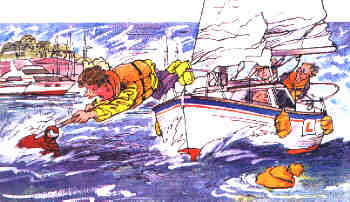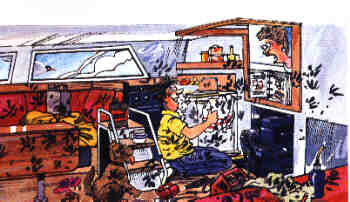 |
Safety Resources | Safety Pages | Boater's Checklist | Float Plan |
|
|
|
| Table of Contents | Communications | Navigation | Organizations | Manufacturers | Sea Tow | | |
 |
Safety Resources | Safety Pages | Boater's Checklist | Float Plan |
|
|
|
| Table of Contents | Communications | Navigation | Organizations | Manufacturers | Sea Tow | | |
 |
Safety on the Sea Foreword |
|
| These images were reproduced with the kind permission of the Royal National Lifeboat Institution of the U.K. For over 170 years the volunteer crews of the Royal National Lifeboat Institution have been saving lives at sea. Since the RNLI's Foundation in 1824, over125,000 lives have been saved. | ||
 |
The following are safety guidelines and suggestions. For more detailed information,
please view the Safety Resources page which contains links to the U.S. Coast Guard safety
pages, the National Safety Foundation, the U.S. Power Squadron and the Coast Guard
Auxiliary as well as an on-line boating safety course.
![]()
 |
HOW TO GET ADVICE BEFORE BUYING YOUR BOAT1. Decide on the type of boat that you can handle and is most suitable for your purpose
|
 |
GET SOME TRAINING1. Before putting to sea, for your family's sake, you MUST acquire basic skills in
Seamanship, Navigation, Rules of the Road, use of safety equipment and boat/engine
maintenance. 2. Your skills, and those of your crew, are your greatest asset, particularly
if things go wrong. |
 |
WHAT TO DO BEFORE SETTING OFF:1. Check the weather forecast by: |
 |
4. Ensure safety equipment is provided for all on board 5. Check on local conditions e.g. tide races, areas of shallow water and know the "Rules of the Road" (on the Safety Resource Page on this site) - Your life may depend on it. 6. Obtain relevant charts and tide tables 7. Plan the trip: - How long will it take? - Who will keep watch? - What access do you have to safe havens en route? - What are the alternatives? Note: For a quick lesson on what to do if you are ever in a position like our unlucky friend to the left, please see "Salvage" on our Safety Resources Page. |
 |
OTHER IMPORTANT CONSIDERATIONS:1.File a float plan with someone you can trust -
the Coast Guard recommends a friend, family member or other responsible party. |
 |
3. Ensure that parked vehicles and trailers do not obstruct slipways or
access for emergency vehicles/lifeboats and are above the high water mark 4. Know your limitations: - Sail within your own ability and that of your crew - Ensure you have sufficient experienced crew for the trip, particularly if it is overnight - Know the limitations of your boat - Do not overload the boat as it will make it unstable Move on to Part 2 |